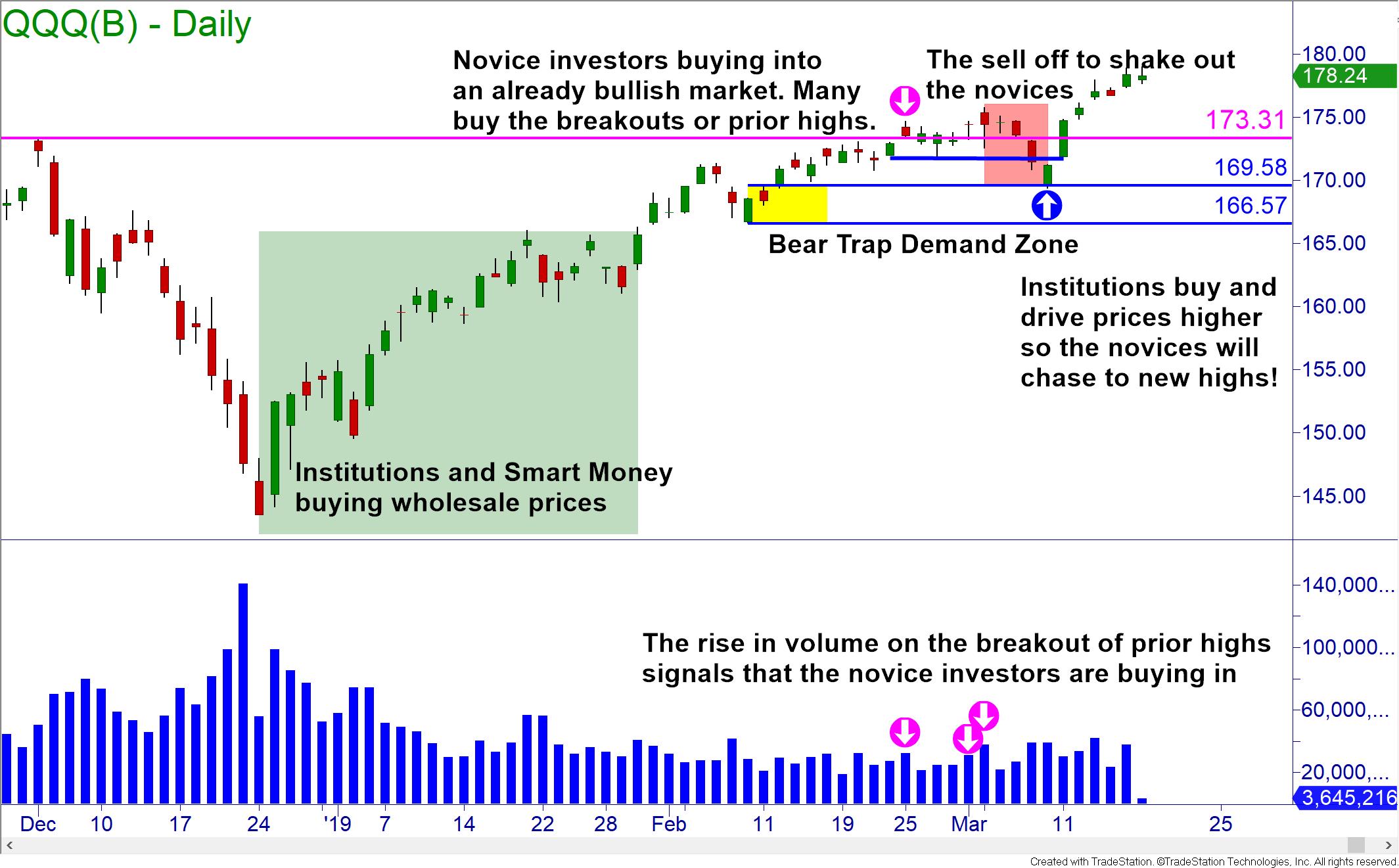There are many dangers inherently found when investing or trading in the equity markets. But what increases your risk is not knowing how to identify or avoid the many traps purposely set up to take your money. One such trap is the Bear Trap in Stocks.
Markets move higher because of an imbalance between buying and selling pressure. For example, when there are a lot of people wanting to buy but no sellers to match them at the current price. In this instance, to attract sellers, the buyers will raise their bids, (the price they are willing to pay for the stock). The higher price is likely to attract sellers to meet the demand.
The problem is that when anyone buys a stock, they automatically become selling pressure on that stock. Remember, once you own a stock, you only profit from it once you sell it (unless you earn dividends on the stock). So, if too many people buy the stock, it will diminish the buying pressure and increase the potential selling pressure.
What is a Bear Trap?
In order to create more demand and get the prices of stocks to move higher, institutions need to shake out the amateur/novice traders. They do this by pushing prices lower to make it seem like the stock or the markets are becoming bearish. The fear of losing their small profits, or of losing money in general, will force the novices into selling their stocks. Once a trader has been stopped out or tricked into selling their stock, they will frequently jump back in if they see the prices moving upwards beyond the price that they had originally bought in. This, in turn, creates more demand and drives the prices higher just as the institutions wanted.
When to Expect a Bear Trap
Institutions buy stocks at wholesale prices, usually after they drop. This will cause downtrends to reverse and markets to rise. This is the best time to buy, but many amateur and novice investors and traders wait and buy once they see that prices are already bullish. Worse yet, many people are taught to buy breakouts and chase price as it moves higher. This signals to the institutions that it may be time to set the bear trap on the stock. When you see an increase of volume accompanying a breakout in price, a bear trap is usually not far off.
Bear traps on stocks can also be found on intraday charts. The same setup is usually observed, prices breaking out to fresh highs where institutions will sell or short sell to the novices buying the breakout. This halts the upward movement and scares the novices into panic, causing them to sell their stock or triggering their stops. Once the price drops into demand, the institutions buy to cover their shorts and send prices higher where novices will jump back in for fear of missing out.
How to Trade a Bear Trap
To be profitable in the markets, you want to trade like a professional. Bear traps on stocks are usually set in the same circumstances as those described above. Now that you know what the professionals are looking for to set the bear trap and how they trade them, you could trade and invest right alongside of the smart money.
If you follow OTA’s Core Strategy, you have a set of rules and will trade and invest with the dominant trend and quality demand and supply zones. There are also Bull Traps that can be a danger or an opportunity for traders. To learn more about the Core Strategy and/or other market traps and opportunities, visit your local Online Trading Academy Center today.
Read the original article here - What is a Bear Trap on the Stock Market?
Neither Freedom Management Partners nor any of its personnel are registered broker-dealers or investment advisers. I will mention that I consider certain securities or positions to be good candidates for the types of strategies we are discussing or illustrating. Because I consider the securities or positions appropriate to the discussion or for illustration purposes does not mean that I am telling you to trade the strategies or securities. Keep in mind that we are not providing you with recommendations or personalized advice about your trading activities. The information we are providing is not tailored to any individual. Any mention of a particular security is not a recommendation to buy, sell, or hold that or any other security or a suggestion that it is suitable for any specific person. Keep in mind that all trading involves a risk of loss, and this will always be the situation, regardless of whether we are discussing strategies that are intended to limit risk. Also, Freedom Management Partners’ personnel are not subject to trading restrictions. I and others at Freedom Management Partners could have a position in a security or initiate a position in a security at any time.
Editors’ Picks

EUR/USD stabilizes above 1.1350 on Easter Friday
EUR/USD enters a consolidation phase above 1.1350 on Friday as the trading action remains subdued, with major markets remaining closed in observance of the Easter Holiday. On Thursday, the European Central Bank (ECB) announced it cut key rates by 25 bps, as expected.

GBP/USD fluctuates below 1.3300, looks to post weekly gains
After setting a new multi-month high near 1.3300 earlier in the week, GBP/USD trades in a narrow band at around 1.32700 on Friday and remains on track to end the week in positive territory. Markets turn quiet on Friday as trading conditions thin out on Easter Holiday.

Gold ends week with impressive gains above $3,300
Gold retreated slightly from the all-time high it touched at $3,357 early Thursday but still gained more than 2% for the week after settling at $3,327. The uncertainty surrounding US-China trade relations caused markets to adopt a cautious stance, boosting safe-haven demand for Gold.

How SEC-Ripple case and ETF prospects could shape XRP’s future
Ripple consolidated above the pivotal $2.00 level while trading at $2.05 at the time of writing on Friday, reflecting neutral sentiment across the crypto market.

Future-proofing portfolios: A playbook for tariff and recession risks
It does seem like we will be talking tariffs for a while. And if tariffs stay — in some shape or form — even after negotiations, we’ll likely be talking about recession too. Higher input costs, persistent inflation, and tighter monetary policy are already weighing on global growth.
RECOMMENDED LESSONS
Making money in forex is easy if you know how the bankers trade!
Discover how to make money in forex is easy if you know how the bankers trade!
5 Forex News Events You Need To Know
In the fast moving world of currency markets, it is extremely important for new traders to know the list of important forex news...
Top 10 Chart Patterns Every Trader Should Know
Chart patterns are one of the most effective trading tools for a trader. They are pure price-action, and form on the basis of underlying buying and...
7 Ways to Avoid Forex Scams
The forex industry is recently seeing more and more scams. Here are 7 ways to avoid losing your money in such scams: Forex scams are becoming frequent. Michael Greenberg reports on luxurious expenses, including a submarine bought from the money taken from forex traders. Here’s another report of a forex fraud. So, how can we avoid falling in such forex scams?
What Are the 10 Fatal Mistakes Traders Make
Trading is exciting. Trading is hard. Trading is extremely hard. Some say that it takes more than 10,000 hours to master. Others believe that trading is the way to quick riches. They might be both wrong. What is important to know that no matter how experienced you are, mistakes will be part of the trading process.

The Best brokers to trade EUR/USD
SPONSORED Discover the top brokers for trading EUR/USD in 2025. Our list features brokers with competitive spreads, fast execution, and powerful platforms. Whether you're a beginner or an expert, find the right partner to navigate the dynamic Forex market.


